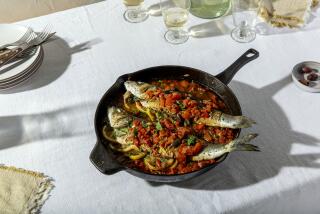To Prevent Migraine, Know the Triggers
A long lie in bed, then a leisurely breakfast of yogurt and orange juice instead of the usual mug of coffee must surely be a healthful way to begin the weekend, right? For some, maybe, but as the Roman philosopher Lucretius said: One man’s meat is another’s poison.
If you are one of the 26 million Americans who suffer from migraines, such a start to Saturday could confine you to bed for the weekend with severe, pounding headaches, disrupted vision, nausea and vomiting.
The precise cause of migraines is not known, although experts generally agree that arterial spasms play a key role. During a spasm, the arteries that supply blood to the brain narrow, reducing blood flow. This prompts the release of brain chemicals that make the arteries reopen, suddenly restoring blood flow.
Bright lights and loud noises are capable of triggering such spasms. And in 20% of migraine sufferers, dietary factors can as well, according to the American Dietetic Assn.
Dietary factors include chemicals or additives in foods, a decrease or increase in daily caffeine intake and dips in blood sugar levels brought on by prolonged periods without food, such as skipping meals or delaying breakfast.
To identify foods and eating patterns that may trigger migraines, sufferers should keep a diary noting what was eaten and drunk, and when, before attacks.
Among the possible triggers are foods rich in amines, a chemical found naturally in yogurt and citrus fruits, and in cheeses such as Stilton, Camembert, Brie, mozzarella, Parmesan and cheddar. Liver, canned meats, pickled herring, dried smoked fish, chocolate, sour cream, foods containing yeast and Chianti wine may also contain amines. Additives can also be to blame, such as nitrite preservatives, which are added to hot dogs and luncheon meats, and monosodium glutamate, a flavor enhancer found in chips, soy sauce, marinades and seasonings.
In such instances, preventing migraines may be as simple as avoiding the offending food and drink and having regular meals.
Adding nutrients and foods to the diet might also prove helpful. A 1998 study by Belgium scientists published in the journal Neurology discovered that over a three-month period, 400 milligrams a day of the B vitamin riboflavin reduced migraine attacks by half.
Although 400 milligrams of riboflavin is about 200 times the minimum daily requirement of this vitamin, its low cost and apparent lack of side effects suggest that further research could be warranted to fully explore its migraine preventing potential.
Flaxseed oil and oily fish, including mackerel and salmon, could also be a useful addition to an anti-migraine diet. They are rich in omega-3 oils, which seem to reduce levels of blood chemicals that cause blood vessels to spasm. But before giving such dietary changes a try, get a proper diagnosis of migraines from your physician and make sure he or she recommends the move as part of your overall prevention and treatment plan.
*
Amanda Ursell, a dietitian and nutritionist, is a London-based freelance journalist. Her column appears twice a month. She can be reached at [email protected].
More to Read
Eat your way across L.A.
Get our weekly Tasting Notes newsletter for reviews, news and more.
You may occasionally receive promotional content from the Los Angeles Times.








